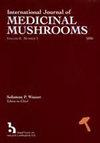姬松茸提取物的化学和药用特性及干基木中重金属含量的分析
IF 1.4
4区 生物学
Q4 MYCOLOGY
International journal of medicinal mushrooms
Pub Date : 2024-05-01
DOI:10.1615/intjmedmushrooms.2024054187
引用次数: 0
摘要
在本手稿中,我们研究了Armillaria ostoyae的甲醇提取物和乙醛提取物的化学和药用特性,以及其干基枝中重金属的含量。我们采用 HPLC-DAD-MS/MS 方法分析了提取物中的化学成分。结果表明,含量最高的矿物质是钾,含量最高的有机酸是苹果酸,含量最高的碳水化合物是果糖,含量最高的多酚类物质是绿原酸。抗菌潜力采用微量稀释法进行评估,结果介于 0.62 至 20 毫克/毫升之间。通过 DPPH(甲醇提取物的 IC50 为 619.67 μg/mL,乙酰提取物的 IC50 为 533.65 μg/mL)和还原力检测(结果范围为 0.025-0.078 μg/mL)研究了抗氧化潜力。总酚含量以没食子酸当量表示(甲醇提取物 - 6.12 毫克 GAE/克;乙酸提取物 - 3.99 毫克 GAE/克)。通过α-淀粉酶(结果在 39.62% 到 44.33% 之间)和α-葡萄糖苷酶(结果在 0.27% 到 2.51% 之间)检测,探索了抗糖尿病的潜力。乙酰胆碱酯酶抑制试验证明了其神经保护活性(结果范围为 3.06-6.09%)。使用微四氮唑检测法研究了细胞毒性潜力,IC50 值在 221.96 到 400 μg/mL 之间。采用 AAS 法评估了干基部藻体中的重金属含量,铁是含量最高的金属。Armillaria ostoyae 是一种有条件食用的蘑菇,以前没有对其进行过深入研究,因此这项研究将为人们提供有关该物种的宝贵知识。本文章由计算机程序翻译,如有差异,请以英文原文为准。
The Analysis of Chemical and Medicinal Properties of Armillaria Ostoyae (Agaricomycetes) Extracts and the Presence of Heavy Metals in Dry Basidiocarps
In this manuscript, we investigated the chemical and medicinal properties of methanolic and acetonic extracts of Armillaria ostoyae and the presence of heavy metals in its dry basidiocarps. The chemical content of extracts was analyzed with the HPLC-DAD-MS/MS method. According to our results, the most abundant mineral was potassium; the most abundant organic acid was malic acid; the most abundant carbohydrate was fructose, and the most abundant polyphenol was chlorogenic acid. The antimicrobial potential was evaluated using the microdilution assay, and the results ranged from 0.62 to 20 mg/mL. Antioxidant potential was studied by DPPH (IC50 of the methanolic extract was 619.67 μg/mL and of the acetonic extract was 533.65 μg/mL) and reducing power assays (the results ranged 0.025-0.078 μg/mL). Total phenolic content was presented as gallic acid equivalent (methanolic extract - 6.12 mg GAE/g; acetonic extract – 3.99 mg GAE/g). The antidiabetic potential was explored by applying the α-amylase (the results ranged from 39.62 to 44.33%) and α-glucosidase assays (the results were in the range of 0.27–2.51%). The neuroprotective activity was asserted by the acetylcholinesterase inhibition assay (the results were in the range of 3.06-6.09%). The cytotoxic potential was investigated using the microtetrazolium assay, and the IC50 values ranged from 221.96 to > 400 μg/mL. Heavy metal content of the dry basidiocarps was evaluated using the AAS method and iron was the most abundant metal. Armillaria ostoyae is a conditionally edible mushroom, which was not studied thoroughly before, thus this research will provide valuable knowledge about this species.
求助全文
通过发布文献求助,成功后即可免费获取论文全文。
去求助
来源期刊
CiteScore
2.60
自引率
16.70%
发文量
91
审稿时长
6-12 weeks
期刊介绍:
The rapid growth of interest in medicinal mushrooms research is matched by the large number of disparate groups that currently publish in a wide range of publications. The International Journal of Medicinal Mushrooms is the one source of information that will draw together all aspects of this exciting and expanding field - a source that will keep you up to date with the latest issues and practice. The International Journal of Medicinal Mushrooms published original research articles and critical reviews on a broad range of subjects pertaining to medicinal mushrooms, including systematics, nomenclature, taxonomy, morphology, medicinal value, biotechnology, and much more.

 求助内容:
求助内容: 应助结果提醒方式:
应助结果提醒方式:


